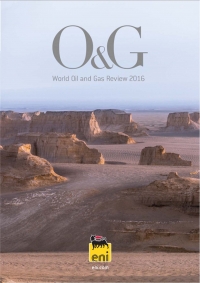Eni: World Oil and Gas Review - 2016 - eng (pdf)
Eni presents the 15th edition of the World Oil and Gas Review, the annual statistical review of the global oil and natural gas market and the refining sector.
- In 2015, oil reserves showed an increase while gas reserves recorded a decline.
- Oil production set another yearly record growth driven by the Middle East and North America.
- The crude quality analysis showed a significant increase of the “heavy sour” crude category, after the commercialization of the new Iraqi crude Basrah heavy.
- Oil consumption grew by 2%, one of the biggest increase recorded in recent years.
- In the last five years world refining capacity has grown by more than 4 Mb/d: in this frame Asia, mainly China, played a key role.
- Gas production, driven by USA and Iran, increased by 1.6%.
- Gas consumption started to grow again (+1.7%) with a strong increase in some emerging markets but also in mature areas like North America and Europe. Asia stopped its continuous growth.
Year 2015 proved a slight increase in oil reserves against a decline in gas reserves.
Oil production set another yearly record growth (+2.9%) driven by the Middle East and North America. Among the top ten producers, Iraq showed the biggest rise and the USA, the largest producer, kept on growing for the seventh year in a row. Geopolitics still affect the production of Libya, Syria and Yemen.
In the crude quality analysis emerged a significant increase of the “heavy sour” category (+12%) due to the new Iraq stream of Basrah heavy that has been commercialized since June 2015, together with “ultra light” crudes (+6%), directly related to shale oil condensate production, and “heavy sweet” crudes (+8%).
World oil demand grew by 1.8 Mb/d (+2.0%), one of the biggest increases in the recent years stimulated to a large extent by the rapid fall in oil prices that began in the second half of 2014 gaining momentum in 2015. The OECD countries have interrupted their structural decline trend (+0.4 Mb/d; +1.0%) while non-OECD countries’ growth slowed down (+1.4 Mb/d; +3.0%) mainly due to the main oil producing countries consumption reduction (Latin America and Russia).
In the last five years world refining capacity has grown by over 4 Mb/d where Asia, in particular China, has been the main contributor followed by North America and Middle East. The fall in the domestic demand together with the increasing foreign competition have pushed Europe to curb refining capacity.
In 2015, world gas production increased by 1.6%, driven by USA and Iran (+5% each). In Europe, Norway had a strong production increase (+8%), whereas European Union output continued to decline (-8.5%). In Russia, which is the world’s second gas producer, after the previous year’s decline, output grew by 1.3%.
Gas demand started to rise again in 2015 (+1.7% against -0.2% in 2014) with a strong increase in some emerging markets (MENA +4.8%) but also in mature areas like North America (+2.2%) and Europe (2.2%). Asia stopped its continuous growth as a consequence of a slowdown in China (+3.1% vs +9.4% in 2015) and a strong decline in Japan and South Korea (-6.0% and -8.8% respectively), due to the restart of nuclear plants and an increasing role for coal and renewables in power.
- Eni: World Oil and Gas Review - 2016 - eng (pdf) (11 МБ) (871 Скачиваний)


































